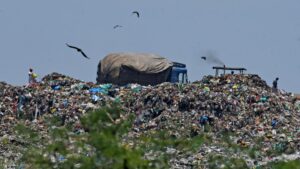For the communities living in the shadow of a proposed Waste-to-Energy (WTE) incineration plant in North Chennai’s Kodungaiyur, the primary question is deeply personal: “How will this affect my family’s health?” While promoted as a technical fix to the garbage crisis, a growing body of evidence exposes these plants as major polluters, linking their emissions to serious health issues, from chronic respiratory diseases to cancer. This is not just a theory; a 2025 fact-finding report on Hyderabad’s Jawaharnagar WTE plants documented alarmingly high levels of poisonous heavy metals like lead and mercury in the surrounding environment. Similarly, a Central Pollution Control Board (CPCB) expose in September 2025 highlighted that toxic ash from these plants, which contains dangerous levels of dioxins and heavy metals, is often not disposed of safely, risking the contamination of soil and groundwater.
Furthermore, an investigation by Article-14 concluded that WTE plants, once seen as a panacea, are now “worsening toxic air in cities.” The New York Times also reported on the direct link between burning garbage and deadly air pollution in India, highlighting that incineration simply transforms solid waste into airborne poison.
If these plants are worsening air quality, as investigations by Article-14 and The New York Times suggest, it is crucial to understand the specific pollutants involved and how they harm the human body for an informed public debate.
The Toxic Cocktail: What Comes Out of the Stack?
The health risks are not caused from a single pollutant, but from a complex mixture of substances released during the incineration process. A 2019 Global Alliance for Incineration Alternatives’ (GAIA) factsheet on ‘Waste Incineration: Pollution and Health Impacts’, which synthesizes the best available evidence, highlights specific concerns:
- Dioxins and Furans (PCDD/Fs): These are highly toxic, persistent organic pollutants that can accumulate in the food chain and human body fat. These are highly potent carcinogens linked to cancer, neurological damage, and disruption of reproductive and immune systems.
- Particulate Matter (PM10/PM2.5): These are microscopic solid or liquid particles small enough to be inhaled deep into the lungs. It aggravates asthma, causes chronic lung disease, and triggers heart attacks, as well as acidic gases and volatile organic compounds that irritate the respiratory tract and other organs.
- Heavy Metals: Including lead, mercury, cadmium, and arsenic, these are known for their toxicity. Mercury exposure damages the brain, kidneys, and nervous system. Lead is a particular danger as a potent neurotoxin with no safe level of exposure, causing cardiovascular problems and being especially harmful to children’s development.
- Other Pollutants like Nitrogen oxides (NOx) and sulfur oxides (SOx) damage lung tissue and irritate the eyes, nose, and throat, while chemicals like PAHs are known carcinogens and hormone disruptors.
How These Pollutants Harm the Body?
Once released into the air and settle on soil, water, and food crops, these pollutants can enter the human body through inhalation, ingestion, or skin contact. Inside the body, they trigger harmful biological processes:
- Inflammation and Oxidative Stress: Pollutants like particulate matter and dioxins can trigger the body’s inflammatory response and cause oxidative stress, a state where harmful free radicals damage cells. This is a key mechanism in the development of cardiovascular and respiratory diseases.
- Genetic and Cellular Damage: Some pollutants are capable of causing genetic mutations or interfering with cell signaling pathways. Dioxins and certain heavy metals can act as carcinogens, directly damaging DNA or disrupting the processes that control cell growth, leading to cancer.
- Impacts on Pregnancy: For pregnant women, the inflammatory and oxidative properties of these pollutants can affect normal placental development and function. This can disrupt the nutrient and oxygen supply to the fetus, potentially resulting in adverse birth outcomes like preterm delivery or abnormal fetal growth.
A Call for Precaution in Kodungaiyur
The scientific evidence paints a clear picture: the pollutants emitted from WTE incinerators are biologically capable of, and have been epidemiologically linked to, a range of serious health ailments. For a community like Kodungaiyur, already burdened by an existing corporation dumpyard and over 36 red category industries, the proposed plant does not represent a solution but an additional health hazard. The potential for increased risks of cancer, respiratory and heart diseases, and harm to the most vulnerable, children and unborn babies, demands a precautionary approach. Informed by this evidence, the community’s resistance is a justified stand for public health and a sustainable, non-toxic future.
Centre for Financial Accountability is now on Telegram and WhatsApp. Click here to join our Telegram channel and click here to join our WhatsApp channeland stay tuned to the latest updates and insights on the economy and finance.


